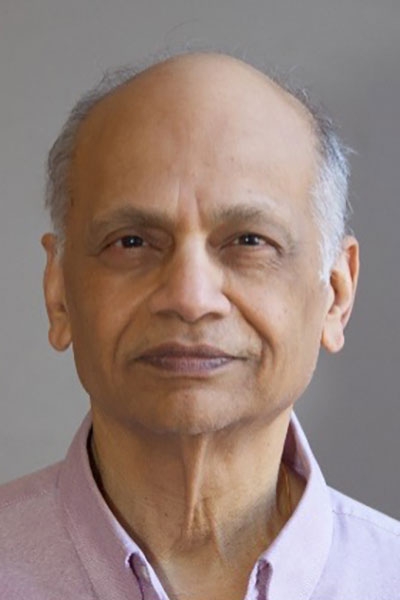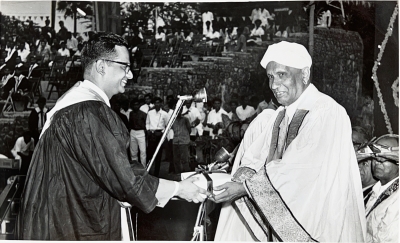
With great sadness, we announce the passing of Professor Subbarayan Pasupathy, affectionately known as Pas.
Pas was talented, warm-hearted, and exceptionally accomplished. A beloved husband, father, loving community leader, and distinguished academic, Pas is survived by his devoted wife, Jaya Pasupathy, his loving daughter Vani Pasupathy, his son-in-law Suneil Sastri, and his grandson Jayen Sastri.
Pas was born in Chennai, India, on September 21, 1940. He received the Bachelor’s degree in Telecommunications from the College of Engineering, Guindy, Chennai (now known as Anna University) in 1963. In 1966, he graduated at the Indian Institute of Technology (IIT), Madras, receiving the Siemens Prize for achieving first place in the M.Tech. program. The picture below shows him receiving this award from Nobel Laureate CV Raman. Pas obtained the M. Phil. and Ph.D. degrees in engineering and applied science from Yale University, New Haven, CT, U.S.A., in 1970 and 1972, respectively. His Ph.D. thesis was in Sonar and was done under the supervision of Professor Peter Schultheiss.

Pas developed a passion for teaching very early in his career. He was a Research Scholar and Part-Time Lecturer at IIT, Madras, and a Teaching Assistant at Yale University. In 1973 he joined the faculty of the University of Toronto, rising to the rank of Professor of Electrical Engineering in 1983. His academic career spanned more than 35 years in undergraduate teaching and research at the University of Toronto. One of his great accomplishments is the large number of graduate students and postdoctoral students he trained over this period, many of whom have gone on to distinguished academic and industry careers of their own.
Pas was an international authority on the application of statistical communication theory and techniques to the design of digital communications systems. He was the first Canadian professor in communications to be listed in the prestigious “highly cited researchers” list of the ISI Web of Knowledge, attesting to the widespread influence that his research had on both theory and practice. He contributed high quality scholarly work to leading journals and conferences—more than 275 articles and contributions to 3 books. His work has been cited in more than 100 patent applications. His specific areas of expertise included bandwidth-efficient digital communication systems and applications of statistical communication theory in a wide variety of systems, including array processing, computer algorithms for signal processing, advanced transceiver structures, mobile cellular networks, and coding algorithms and architectures. His papers on partial-response signaling and minimum-shift-keying modulation are particularly highly cited. He was elected Fellow of the IEEE in 1991 “for contributions to bandwidth-efficient coding and modulation schemes in digital communication”. He received the 2003 Canadian Award in Telecommunications Research from the Canadian Society of Information Theory. He was elected Fellow of the Engineering Institute of Canada in 2004 and Fellow of the Canadian Academy of Engineering in 2007.
Professor Pasupathy served as: Associate Editor for Data Communications and Modulation for the IEEE Transactions on Communications; Technical Associate Editor for the IEEE Communications Magazine; and Associate Editor for the Canadian Electrical Engineering Journal. He coordinated the Special Issue on “Canadian Telecommunications” of the IEEE Communications Magazine, published in January, 1981. In the IEEE Communications Magazine Centennial issue of 1984, he started a humour column “Light Traffic” which he continued to publish for 14 years. Pas greatly enjoyed word play, including the construction of palindromes related to his technical interests.
A workshop in honour of Professor Pasupathy was held at the University of Toronto in May 2007, and was attended by many of his colleagues, former students, and postdocs. The IEEE's The Institute newspaper published a profile of him in its January 7, 2008 issue, and the IEEE Communications Magazine published an article about him in March 2008. He was honoured as a Distinguished Alumnus by IIT Madras, India, his alma mater, in April 2010.
Pas’s curiosity and creativity extended beyond technical subjects. After hours, Pas had numerous hobbies and was incredibly talented. Tamil scholar, artist, poet, musicologist, orator and wise elder in his community, his eloquent words were always cherished. He proudly attributed his success as a researcher and teacher to the culture that was his inheritance via his Indian heritage. He won a Lifetime Achievement Award from Tamils’ Information Magazine in 2019, and in his acceptance speech he quoted “every art is a self-portrait of the artist, so autograph your work with excellence.” He followed this standard in all endeavours, both professionally and personally. His wise, brilliant, gentle, and humorous nature will be much missed by all who had the privilege of interacting with him.
https://www.comm.utoronto.ca/~pas/pictures/Jan_81
https://www.comm.utoronto.ca/~pas/ltraffic.html
Leave a comment or photo.
Comments
Frank Kschischang | 6 March 2023
I am shocked and saddened to learn of the passing of my mentor, my advisor, my friend, Pas Pasupathy. Pas was the epitome of the phrase "a scholar and a gentleman". He was charming, he was witty. He was a huge fan of Sir Arthur Conan Doyle. He was a brilliant student. Upon receiving a book prize (money to purchase books) as an academic prize, his professors were bemused when he decided to purchase Sherlock Holmes novels rather than books about mathematics or science.
He enjoyed word play. For many years he contributed a column "Light Traffic" to the IEEE Communications Magazine where he wrote about such topics as "The Glories of Gaussianity". He introduced a character, "Dr. O. Lord", first name "Otto", an expert in "radar", who only spoke in palindromes. He mused about metrics, made jokes about codes, created quizzes and games.
I am proud to say that his name and mine will forever be intertwined as the discoverers of KP36, the "Kschischang-Pasupathy lattice", the densest known lattice packing of 36-dimensional spheres.
Thank you, Professor Pasupathy, for all of your guidance, your wisdom, your humour over many years. Thank you for taking me as a student. You will be missed, but never forgotten.
Ryuji Kohno | 7 March 2023
I’m so sorry to hear about Professor Subbarayan Pasupathy‘s passing.
He was a host professor of my visiting post-doctoral researcher at the University of Toronto during 1984-1985. He was such an extraordinary supervisor and coordinator for every visitor, guest, and student. In particular, the visit was my first experience working outside Japan and the best life in my long international activities because I could make many friends and have various experiences with fun under Pas's offer for my work in Toronto. Without this knowledge, I have had no academic or other international activities for over 38 years. I have been following your manner of taking care of younger and less experienced colleagues.
With my deepest condolences.
Ryuji Kohno


